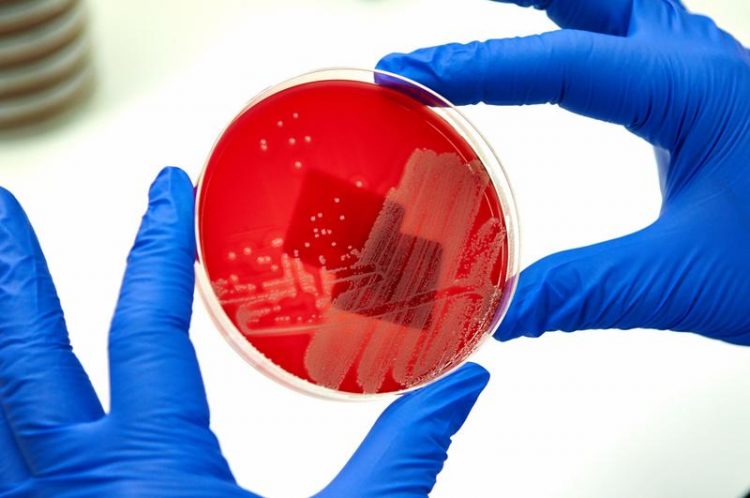A new study shows how dangerous germs travel as stowaways from one continent to another

Using a special culture, germs from smears can be recognized and identified Photo: WWU/H. Dornhege
Everyday life at an airport: there’s still time before the jet taking passengers to faraway countries takes off – time enough for a quick visit to the toilet. What awaits passengers there is not always a pleasant sight. However, what they don’t see can be much worse.
As scientists from Münster University, in collaboration with the Robert Koch Institute in Berlin, have now demonstrated, toilets at airports are also a “transfer point” for germs. The researchers found these germs on smears taken from inside door handles in numerous toilet cubicles worldwide – and these include germs against which traditional antibiotics for the treatment of bacterial infections are not, or only partially, effective. They travel all over the world as stowaways, so to speak, for example from India to France. The team has now published its findings in the journal “Clinical Microbiology and Infection“.
The researchers, headed by Dr. Frieder Schaumburg and Prof. Karsten Becker – both from the Institute of Medical Microbiology at Münster University Hospital – examined a total of 400 door handles at 136 airports in 59 countries. The smears were taken between December 2012 and November 2015.
The inside door handles in toilet cubicles are especially suitable as objects of study: “A door handle is used by a large number of people,” says Schaumburg, “It’s also the last thing that a visitor makes contact with after he has used the toilet and before he washes his hands. The door handle is then particularly contaminated with germs, for example from the skin or the intestines.”
A culture was made, using a special medium, of the germs found in the smears from the door handles and they were then identified. The researchers analysed the species and the genetic material of each pathogen they found. What they found particularly frequently was Staphylococcus aureus, which occurred in around one in twenty specimens (5.5%), followed by Stenotrophomonas maltophilia (2%) and Acinetobacter baumannii (1.3%). Some of these pathogens showed resistances.
The researchers had assumed that airline passengers could bring home so-called multi-resistant “supergerms” from trips to faraway countries, and this was confirmed by the findings. “One of the MRSA pathogens found in a specimen from Paris was highly unusual for this region,” Becker explains. “It is found primarily in India, so it must have been brought to Paris by humans.”
This is a potentially explosive issue, because Staphylococcus aureus pathogens – or MRSA for short – are far from being harmless bacteria. They represent a substantial danger for people because, once inside the body, they can lead to infections in the most widely varying places. At the same time, these pathogens are resistant to the most effective antibiotics such as penicillin and related substances. Even though the contamination found on the door handles examined is at a low level overall, the study produced in Berlin and Münster demonstrates that international airline passengers can pick up and spread dangerous pathogens – including anything up to “supergerms”.
The advice which the authors give, following their findings, is not new, but still as important as ever: “Washing the hands thoroughly is imperative after using the toilet, no matter where that may be,” is what Prof. Karsten Becker recommends. “In public toilets, any skin contact with surfaces should be kept to an absolute minimum. And here – although not at home – as an alternative, it makes sense to use an alcohol-based hand disinfectant instead of soap.”
Media contact:
Dr. Thomas Bauer
Referent Research and Teaching at Münster University Medical Faculty
phone: 0251-83-58937
mobile: 0171-4948979
email: thbauer@uni-muenster.de
Original publication:
Schaumburg F. et al: Airport door handles and the global spread of antimicrobial-resistant bacteria: a cross sectional study. Clinical Microbiology and Infection (in press, available online 23 September 2016); DOI: http://dx.doi.org/10.1016/j.cmi.2016.09.010
Media Contact
More Information:
http://www.uni-muenster.de/All latest news from the category: Health and Medicine
This subject area encompasses research and studies in the field of human medicine.
Among the wide-ranging list of topics covered here are anesthesiology, anatomy, surgery, human genetics, hygiene and environmental medicine, internal medicine, neurology, pharmacology, physiology, urology and dental medicine.
Newest articles

A ‘language’ for ML models to predict nanopore properties
A large number of 2D materials like graphene can have nanopores – small holes formed by missing atoms through which foreign substances can pass. The properties of these nanopores dictate many…

Clinically validated, wearable ultrasound patch
… for continuous blood pressure monitoring. A team of researchers at the University of California San Diego has developed a new and improved wearable ultrasound patch for continuous and noninvasive…

A new puzzle piece for string theory research
Dr. Ksenia Fedosova from the Cluster of Excellence Mathematics Münster, along with an international research team, has proven a conjecture in string theory that physicists had proposed regarding certain equations….



